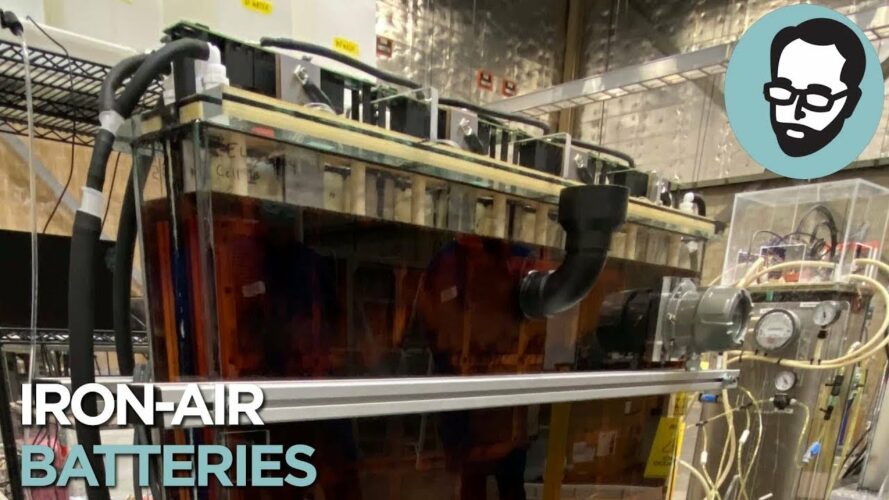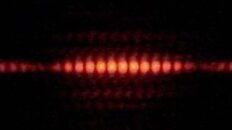Grid energy storage is one of the hottest areas of research and engineering today. It’s all about cheap, sustainable, and efficient materials, which makes iron-air batteries stand out amongst the others. Not only is iron plentiful and cheap, it’s completely recyclable and even better – rechargeable. Let’s look at iron-air battery technology and see how likely it is to transform our energy grid.
TRANSCRIPT:
Over the last couple of years I’ve had something of a series of videos on this channel covering various types of battery technology. It’s not a formal thing exactly, but it’s a popular subject and there seems to be new ones all the time so there’s no shortage of topics.
I’ve covered liquid metal batteries, solid state batteries, redox flow, lithium ion of course, and most recently aluminum air and with each and every one of these videos, just as I was finishing up, Matt Freaking Farrell posts a video on the same topic.
So of course as I was working on a video about Iron Air batteries, there’s one from him, just cutting in line.
But as they say, it’s not who did it first… it’s who did it best. (beat) Of course his graphics are way better than mine so I’m still screwed.
The point is, if you’ve seen Matt’s video… I don’t know, I guess you can skip this one – unless, you just want to see what I might do differently, in which case you’re in luck because I am going to have puppies up on screen. (puppies on screen; smug) Take that, Matt. Check and mate.
And if you haven’t seen Matt’s video, then get ready to learn something… And look at puppies.
I had no idea in October when I made that video about Oxygen that the stuff I talked about in that would be relevant in so many other videos. It was called Oxygen is Killing You and it was about how oxygen is one of the most corrosive elements on the periodic table but weirdly, even paradoxically, that corrosiveness is what makes life possible.
And it’s what makes a lot of things possible, when it comes down to it, pretty much everything is transformed or powered by combustion; or oxidation.
As I covered in the aluminum air battery video, oxygen reacts with aluminum to create aluminum hydroxide. Which by the way, fun fact, whenever you look at anything aluminum, you’re really seeing the thin outer layer of aluminum hydroxide. You’ve probably never actually seen aluminum in your life.
Well it works the same way with iron. Oxygen reacts with iron to form iron oxide, also known as rust. And this process gives off a little bit of energy.
But before we get too far into how the batteries work and everything… I feel like at the beginning of every video I have to explain why we need battery storage, how important energy storage is for renewable energy and all that, but there might be another way of looking at it…
The Battery Bottleneck
The reason we talk about all these different kinds of energy storage is because there are a lot of different use cases, and different batteries are better suited for different purposes.
Lithium-ion is great for EVs because they’re energy dense, so smaller batteries, better for mobility, can be cycled thousands of times, and provide a lot of power to make the zoom-zooms.
They’re great for home storage and grid storage, too, but every battery that goes into that is a battery that’s not going in a car.
And that’s a lot of batteries. Home energy storage was a $6.97 billion dollar market in 2020. And grid storage systems are expected to grow 10-fold between 2019 and 2023.
This is a problem. Because battery availability is the biggest hinderance to the growth of EVs.
Not only are there just not enough batteries to meet demand for EVs these days but it’s this scarcity that keeps the cost of the batteries – and EVs – higher than gas cars.
In fact, some industry experts are warning that demand for lithium ion batteries may soon exceed supply.
Europe has been experiencing a major shortfall this last year, because most of their batteries are coming from Asia, and Covid has wreaked havoc on global trade.
There are new plants coming online in Europe to address this, and that’s obviously a good thing but there is still the deeper problem of raw materials.
Expensive Materials
Most lithium ion batteries rely on expensive materials like lithium, nickel, and cobalt. All of which have to be mined, and in a relatively small number of places on Earth.
And these prices can fluctuate. Lithium has actually tripled this year, which has added about $470 to the cost of every EV, on average.
The point is, lithium ion, for all its great properties, is constrained. And if we want to advance car electrification going forward, it might make sense to find alternative solutions for all those non-mobile storage needs. So we can put lithium ion in the cars and phones and computers to live its best life.
And that is why we keep hearing about all these new battery technologies, everybody’s scrambling to come up with the cheapest, most sustainable option until we finally develop an arc reactor. In a cave. With a box of scraps.
A LiOn Alternative
Now that I’ve said the thing; the thing I say in all these videos… again… Let’s talk about iron air batteries.
How It Works
So, much like the Aluminum-Air Battery I covered about a week after Matt Ferrell, iron-air batteries fall into the category of metal-air batteries, where energy is stored and released through the oxidation of metal.
With metal-air batteries, the anode is the metal and the cathode is oxygen basically.
And the electrolyte of course is a solution of water with stuff dissolved in it to improve conductivity.
As I said before, iron plus water and oxygen equals iron oxide, or rust. and this chemical reaction — rusting — releases electrons to pass through a circuit as current
All this is pretty similar to what we talked about with aluminum, the difference with iron is that this rusting process is reversible. In other words… you can recharge this one.
Yeah, sounds like magic but you can “unrust” the iron by adding current from outside.
And because you can recharge it, it’s made from abundant materials, and it’s totally recyclable, it was considered a potential battery for electric vehicles back in the 70’s and 80’s.
In fact, iron has a theoretical energy density about twice that of lithium ion batteries. So… Why aren’t we seeing them everywhere now?
Short Cycle Life
There’s a few reasons, the first is cycle life.
So yeah, while we’re clapping and celebrating that they’re rechargeable, it’s important to know… They’re kinda just barely rechargeable.
Cycle life refers to the number of times a battery can be charged and discharged before it gives out less energy than was put in.
For example, nickel- and lithium-based batteries can be recharged 300 to 500 times before losing any significant capacity.
Significant, meaning twenty-percent less than a fresh battery. It can go thousands of cycles before it’s totally dead.
— this cites 2000 cycles as a typical cycle life; I think that’s to DEAD
Early iron-air batteries could only do 20-30 cycles. That’s less.
Later models improved on that, but it was still way short of other competing batteries, so, it faded away.
Why do iron-air batteries have such short cycle lives? Well I’m glad you asked, with most metal-air batteries, the problem is the components deteriorate.
I mean all that oxidizing and un-oxidizing and re-oxidizing takes its toll after a while.
In the case of iron-air, the iron anode can theoretically last upwards of 10,000 cycles. That’s not the problem. It’s the cathode and the electrolyte.
https://www.researchgate.net/publication/266150203_A_Review_of_the_Iron-Air_Secondary_Battery_for_Energy_Storage
There’s a membrane on the cathode that regulates air flow. That membrane can react with the electrolyte, causing contamination that decreases cycle life.
Corrosion can cause the battery to self-discharge. So instead of storing energy, the battery bleeds it away while sitting idle. Obviously a problem.
So, those are the kind of problems that have stymied interest in iron-air but there has been a lot of progress made since then.
Recent Innovations
Like less reactive materials for the cathode membrane, and more efficient electrolyte solutions.
And now nanotechnology is getting in on the action.
Anodes of iron nanoparticles have more surface area to carry out reactions.
Nanocomposites of iron and graphene or carbon fiber gives even better results
The company that’s making the most waves in Iron-air batteries is Form Energy, and they have plans to launch a grid-scale iron-air battery in the next few years.
They claim to have solved all the aforementioned problems but they’re keep the details of how they’re doing it a secret.
And I guess we’re just supposed to trust them. As if Nikola Motors and Theranos never existed.
Form Energy
But clearly somebody trusts them because they’ve raised $360 million in investment rounds.
Two of those somebodies being Bill Gates and Jeff Bezos.
So either they really are sitting on some secret sauce that will fix all the problems, or the potential for an Iron Air battery that can compete with Lithium Ion is just that enticing.
It doesn’t hurt that one of their founders is the former Vice President of Products and Programs at Tesla focusing specifically on grid-scale storage.
And they’ve also got on board a Professor of Materials Science and Engineering at MIT who was an innovator of lithium-ion technology back in the day.
In fact, the words “Tesla” and “MIT” pop up a lot in bios of Form executives. Like, this is kind-of the grid energy storage dream team.
And this dream team claims their new battery could be a major step toward a 100% renewable energy grid.
Do you want Bill Gates money? Because that’s how you get Bill Gates money.
An Economical Battery
The individual batteries are made from 10-20 iron-air cells that are stacked to form a battery about the size of a washing machine.
And its anode is the largest ever made, which actually speaks to the economy of the design because despite it using more metal, it’s expected to run at less than a tenth the energy cost of a comparable lithium-ion battery.
This is, of course just based off their claims, as I mentioned, Form is keeping some details to themselves
But it won’t be long before we know if it’s all it’s cracked up to be, there’s actually a pilot program going online in 2023 in Cambridge, Minnesota.
The Pilot Project
It’s called the Cambridge Energy Storage Project and is part of a Green-power makeover by Great River Energy.
Great River plans to QUOTE eliminate coal from its power supply portfolio and add 1,100 megawatts (MWs) of wind energy by 2023 UNQUOTE
1 MegaWatt will be from the Cambridge Project, maybe with more to come
Great River hopes that the project can help prevent extended blackouts, which have been a problem in the past.
A blackout caused by the polar vortex left people without power for up to 72 hours in 2019.
Another blackout kept some without power for 48 hours in 2003. This one caused by a software bug.
On a personal note, I’m actually getting solar and storage on my house right now because of the blackouts we had here in Texas last February. I knew people who were burning their furniture in the fireplace for warmth. But at least they survived, at least 151 people died.
Now some might say that’s all the more reason to not ditch coal and oil, if people are already dying for lack of electricity.
But form hopes their battery could change the conversation by helping secure the grid. We’ll know more when the pilot project kicks off.
What should we expect when it does?
Watts Per Hour
Form makes rather modest claims about the rate at which their batteries can power the grid
The pilot facility will use an acre of land to provide 1 MW/150 MWh of energy
Watts are a measure of how much work can be done, while watt-hours measure work over time
So Form is saying their acre of their batteries will deliver 1 MW to the grid. At a steady 1 MW per hour, they’ll be able to keep this up for 150 hours.
A denser configuration could deliver three times the energy with the same footprint
For comparison, Tesla’s Megapack can deliver 250 MW/1GWh of energy per acre. 250 MegaWatts is enough to power 75,000 homes. Impressive.
Form’s Focus
At 1 MW/150 MWh, Form isn’t looking to power a major city during peak energy demand, their focus is delivering low-cost, long-duration energy.
They’re not looking to replace lithium-ion batteries completely, in fact, the best use of Form’s batteries might be as part of a hybrid system
In times of low energy demand, the iron-air part would provide inexpensive power.
When demand peaks, the lithium-ion batteries would kick in.
But in emergency situations, iron-air batteries could provide days of emergency power, which could save lives during extreme weather events.
So… is Iron Air the end-all, be-all of battery storage? No. But no single battery is.
Which, as I was saying at the beginning, is all the more reason to have a multitude of battery types that can fill specific niches in the most cost-effective and sustainable way possible.
It’s actually a really interesting time to be covering battery technology, and who knows, maybe someday we’ll develop the perfect battery that does all things in all applications. And when we do, I’ll cover it right here… Probably a week after Matt Ferrell.
Tell me your thoughts about the iron air battery and if there’s another battery storage solution that you’re excited about.




Add comment